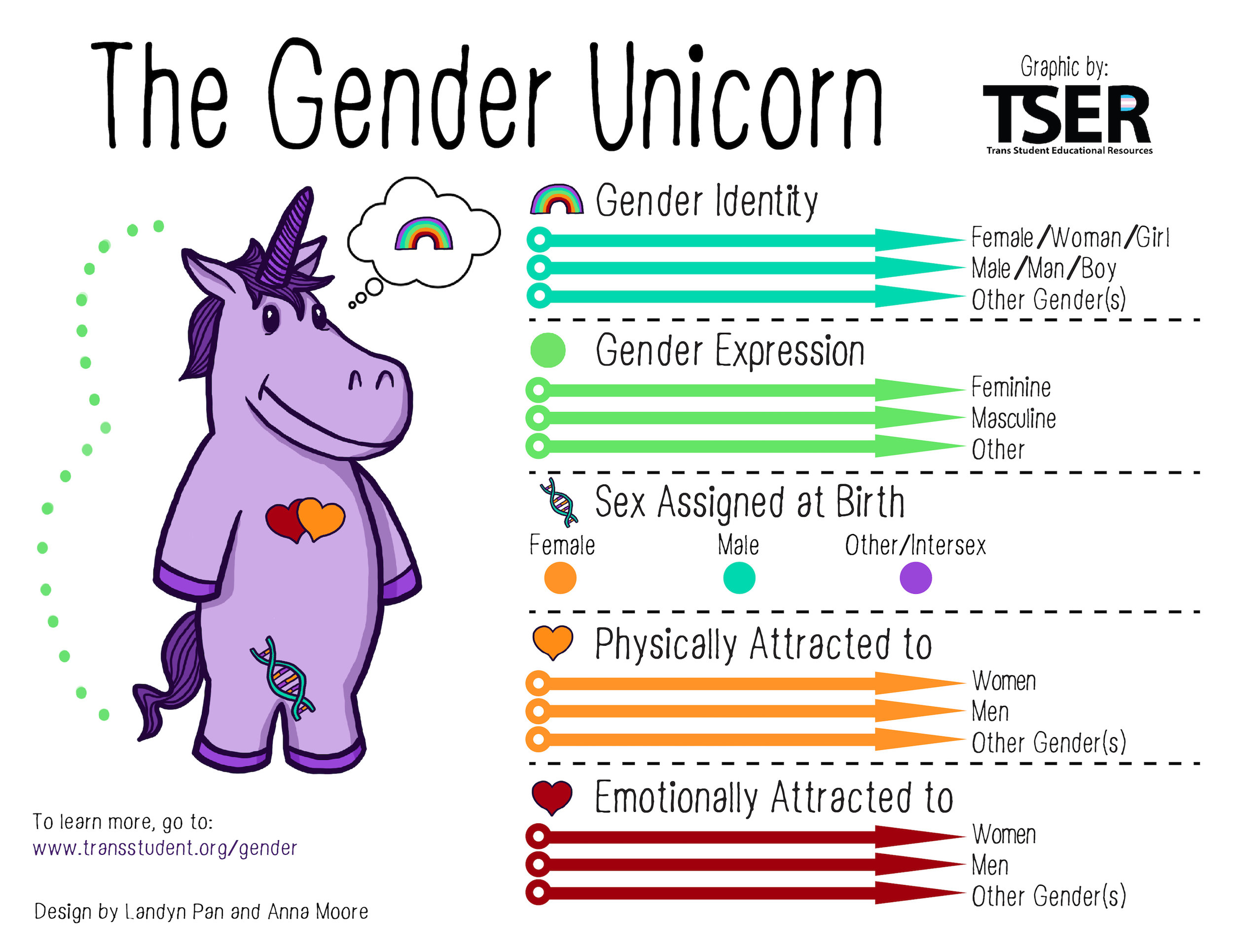The Gender Unicorn
We have a new page! The Gender Unicorn (previously known as the Genderbread Person), is a popular infographic that illustrates four main concepts: gender identity, gender expression, biological sex, physical and sexual attraction. You are welcome to download, print out and distribute this graphic as you wish!
El Unicornio del Género (Spanish) O Unicórnio de Gênero (Portuguese) Гендерный единорог (Russian) 日本語 (Japanese) Das Gender Unicorn (German) La Licorne du Genre (French)
*The Gender Unicorn is not the property of PFLAG Temecula. More information on The Gender Unicorn can be found here.
Illustrations by Anna Moore. Design by Landyn Pan, Eli Erlick, and many others.
Gender Identity: Who You Think You Are.
Gender identity is all about how you, in your head, think about yourself. It’s about how you internally interpret the chemistry that composes you (e.g., hormone levels). As you know it, do you think you fit better into the societal role of “woman,” or “man,” or do neither ring particularly true for you? That is, are you somewhere in-between the two? Or do you consider your gender to fall outside of the spectrum completely? The answer is your gender identity.
It has been accepted that we form our gender identities around the age of three, and after that age it is incredibly difficult to change them. Formation of identity is affected by hormones and environment just as much as it is by biological sex. Oftentimes, problems arise when someone is assigned a gender based on their sex at birth that doesn’t align with how they come to identify. We’ll talk about that more later.
Gender Expression: How You Demonstrate Who You Are
Gender expression is all about how you demonstrate your gender through the ways you act, dress, behave, and interact–whether that is intentional or unintended. Gender expression is interpreted by others perceiving your gender based on traditional gender roles (e.g., men wear pants, women wear dresses). Gender expression is something that often changes from day to day, outfit to outfit, event or setting to event or setting. It’s about how the way you express yourself aligns or doesn’t with traditional ways of gendered expression. And like gender identity, there is a lot of room for flexibility here. It is likely that you slide around on this continuum throughout the week without even thinking about it. How about an example?
You wake up and you’re wearing baggy grey sweatpants and a tshirt. As you walk into your kitchen to prepare breakfast, you’re expressing an adrogynous-to-slightly-masculine gender. However, you see your partner in the kitchen and you prowl in like Halle Berry from Catwoman, then you are expressing much more femininely, so now you’re back on the left half of the continuum. You pour a bowl of cereal, wrap your fist around a spoon like a viking, and start shoveling Fruit Loops into your face, and all-of-a-sudden you’re sliding back onto the right side of the continuum. After breakfast, you skip back into your bedroom and playfully place varying outfits in front of you, pleading your partner help you decide what to wear. You’re feminine again.
I assume this entire time you were imagining it was you, with your gender identity, acting out that example. Now go through the whole thing, but imagine someone with the a different gender identity from you going through the motions. Now you are starting to understand how these concepts interrelate, but don’t interconnect.
Biological Sex: The Equipment Under the Hood
Biological sex refers to the objectively measurable organs, hormones, and chromosomes you possess. Being female means having a vagina, ovaries, two X chromosomes, predominant estrogen, and you can grow a baby in your stomach area. Being male means having testes, a penis, an XY chromosome configuration, predominant testosterone, and you can put a baby in a female’s stomach area. Being intersex can be any combination of what I just described.
For example, someone can be born with the appearance of being male (penis, scrotum, etc.), but have a functional female reproductive system inside. There are many examples of how intersex can present itself, and by clicking here you can see some statistics from the Intersex Society of North America that describe the frequency of intersex births.
Sexual Orientation: Who You Are Attracted To
Sexual orientation is all about who you are physically, spiritually, and emotionally attracted to. If you are male and you’re attracted to females, you’re straight. If you’re a male who is attracted to males and females, you’re bisexual. And if you’re a male who is attracted to males, you’re gay. This is the one most of us know the most about. We hear the most about it, it’s salient in our lives, and we understand where we stand best. It’s pretty cut and dry, right? Maybe.
Interestingly enough, pioneering research conducted by Dr. Alfred Kinsey in the mid-20th century uncovered that most people aren’t absolutely straight or gay/lesbian. Instead of just asking “do you like dudes or chicks?” (very sciency, I know), he asked people to report their fantasies, dreams, thoughts, emotional investments in others, and frequency of sexual contact. Based on his findings, he broke sexuality down into a seven point scale (see below), and reported that most people who identify as straight are actually somewhere between 1 – 3 on the scale, and most people who identify as lesbian/gay are 3-5, meaning most of us are a little bi-.
0 – Exclusively Heterosexual
1 – Predominantly heterosexual, incidentally homosexual
2 – Predominantly heterosexual, but more than incidentally homosexual
3 – Equally heterosexual and homosexual
4 – Predominantly homosexual, but more than incidentally heterosexual
5 – Predominantly homosexual, incidentally heterosexual
6 – Exclusively Homosexual
All information and content provided on this page was pulled from http://itspronouncedmetrosexual.com.

